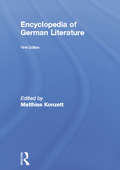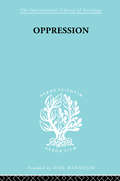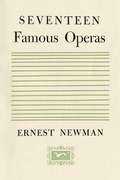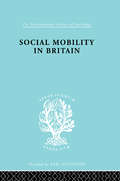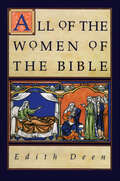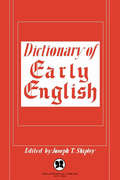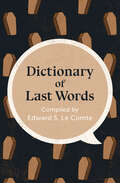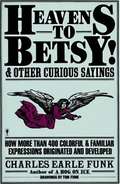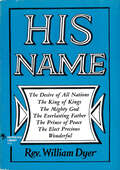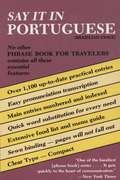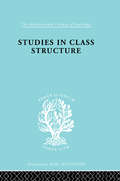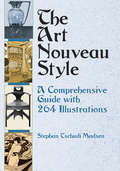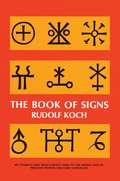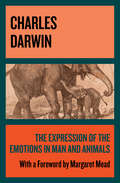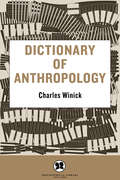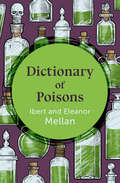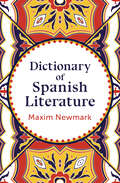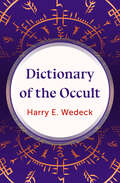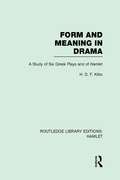- Table View
- List View
Encyclopedia of German Literature
by Matthias KonzettFirst Published in 2000. Routledge is an imprint of Taylor & Francis, an informa company.
Oppression: A Study in Social and Criminal Psychology (International Library of Sociology #A Study In Social & Criminal Psychology)
by Tadesuz GrygierPublished in 1998, Oppression is a valuable contribution to the field of Sociology and Social Policy.
Seventeen Famous Operas
by Ernest Newman“The great composer does not set to work because he is inspired, but becomes inspired because he is working.” –Ernest Newman In Seventeen Famous Operas, renowned musicologist and music critic Ernest Newman goes beyond simply retelling the plots of the operas he has chosen to feature in this volume. Because for Newman, opera was theater—and he demonstrates that with his in-depth studies of the seventeen featured operas. Newman uses biographical, literary, and historical background to expose the reader to how each featured work came to be. These featured works include La Boheme, Madame Butterfly, Carmen, La Traviata, The Marriage of Figaro, The Barber of Seville, The Magic Flute and ten other famous works. Seventeen Famous Operas is a must-read for music librarians, opera lovers, and propagandists of music everywhere.
Six Minutes a Day to Perfect Spelling
by Harry ShefterPeople make spelling mistakes simply because they have never formed the right spelling habits. Here is a proven method that will make you a master speller.
Social Mobility in Britain (International Library of Sociology)
by D. V. GlassThis is Volume XVI of twenty-one in a series on Race, Class and Social Structure. Originally published in 1954, this study looks at social mobility in Great Britain; including social grading of occupations, social stratification, a sample and the educational experience of adults in England and Wales as of July 1949.
Wonders of the Human Body
by Anthony RavielliDetailed, easy to understand children's book about how the human body functions.
All of the Women of the Bible
by Edith DeenA comprehensive history with more than 300 biographies of every woman in the Bible, both the named and nameless, the famous and infamous. All the Women of the Bible offers a rich biographical perspective on every female figure in scripture—including the famous, the little-known, and even the unnamed. In more that 300 engaging and insightful portraits, Edith Deen brings alive the saints and sorceresses, queens and servants, mothers and daughters, wives and widows whose profound influence is felt through-out the Bible.“You can almost trace light and darkness in the Bible by the women themselves,” she writes. “Hannah, praying mother of Samuel, gave birth to a son who became the first great Hebrew prophet. And, of course, there was the mother of Jesus. On the other hand, Jezebel and Herodias were vile influences, the first tearing apart the northern kingdom of Israel, the second causing John the Baptist to be beheaded.”Combining thorough detail with a lively and dramatic narrative, All of the Women of the Bible portrays the real women behind the Biblical stories and shows how, in their human struggles and triumphs, they are very much like the women of today. With each major biography identified by Bible chapter and verse and prefaced by a key passage of scripture, this is an ideal resources for teachers, Bible students, preachers, and writers, as well as anyone who wants to learn what it was really like to be a woman in Biblical times.
Dictionary of Early English
by Joseph T. ShipleyJoseph T. Shipley's tome Dictionary of Early English provides an indispensible and unparalleled reference tool on the study of early English. With a preface by Mark Van Doren and an extensive headword list, this dictionary brings to light the terms, concepts, and vocabulary of ancient English. Joseph T. Shipley has written and edited several books, dictionaries, and anthologies including The Origins of English Words, Modern French Poetry, An Anthology, and Dictionary of World Literature.
Dictionary of Last Words
by Edward S. Le ComteThis A-to-Z compendium presents the last recorded words of more than 1,500 individuals across history, from ancient kings to modern outlaws. A person&’s last words carry intrinsic and enduring fascination, especially if the individual in question is widely remembered or historically significant. Whether profound or pedestrian, these final statements can sum up an entire life—or even prophecy the future. This unique reference volume collects 1,664 quotations representing the last words of some of history&’s most famous, fascinating, and influential personalities. They include kings and queens, statesmen and scientists, poets, saints, criminals, and many others. Dictionary of Last Words is a treasure trove of deathbed pronouncements, last letters, and true gallows humor.
Heavens to Betsy! And Other Curious Sayings
by Charles Earle FunkWhether it's like "a bump on a log" or "a bat out of hell," these expressions have been around forever. Dr. Funk explains over 400 droll, colorful, and sometimes pungent expressions of everyday speech.
His Name: The Desire of All Nations - The King of Kings - The Mighty God - The Everlasting Father - The Prince of Peace - The Elect Precious - Wonderful (Colportage Library #265)
by William Dyer"Worldly excellencies ... cannot satisfy the sense of men, much less can it satisfy the souls of men." Reverend William Dyer knew full well that satisfication is found only when the soul is enamored with Christ, when the magnificent names of God are saturated with sweetness. Walk through seven names that describe the personhood of God, and find satisfaction as you draw yourself close to Him.
His Name: The Desire of All Nations - The King of Kings - The Mighty God - The Everlasting Father - The Prince of Peace - The Elect Precious - Wonderful (Colportage Library #265)
by William Dyer"Worldly excellencies ... cannot satisfy the sense of men, much less can it satisfy the souls of men." Reverend William Dyer knew full well that satisfication is found only when the soul is enamored with Christ, when the magnificent names of God are saturated with sweetness. Walk through seven names that describe the personhood of God, and find satisfaction as you draw yourself close to Him.
Say It in Portuguese (Dover Language Guides Say It Series)
by DoverContains over 1,000 useful sentences and phrases for travel or everyday living abroad: food, shopping, medical aid, courtesy, hotels, travel, and other situations. Gives the English phrase, the foreign equivalent, and a transliteration that can be read right off. Also includes many supplementary lists, signs, and aids. All words are indexed.
Studies Class Struct Ils 121 (International Library of Sociology #Vol. 20)
by G. D. ColeFirst published in 1998. Routledge is an imprint of Taylor & Francis, an informa company.
The Art Nouveau Style: A Comprehensive Guide with 264 Illustrations
by Stephan Tschudi MadsenA revolutionary reaction to traditional nineteenth-century art, the turn-of-the-century Art Nouveau movement drew much of its inspiration from nature. Applying its sinuous, curvilinear motifs to the decorative arts, graphics, architecture, sculpture, and painting, artists and craftspeople attempted to create a style suitable for a "modern" age. In this absorbing, exceptionally detailed, and well-researched book (one of the first scholarly works to revive interest in the style after World War II), a noted Norwegian authority on the subject examines the movement in depth. Stephan Madsen offers a wealth of facts and insights about the origins and development of the style; trends leading up to Art Nouveau, including the influence of Blake and the Pre-Raphaelites; early Art Nouveau posters and book illustrations; and its use in architectural ornamentation, furniture, jewelry, wrought-iron, glass, and other applied arts. A magnificent selection of 264 photographs and line drawings accompanies the text, which gives broad coverage to the movement, as well as insightful discussions of such important artists as Emile Gallé, Alphonse Mucha, Walter Crane, Charles Rennie Mackintosh, Aubrey Beardsley, Henry Van de Velde, Victor Horta, William Morris, and Eugène Grasset.Artists and students, admirers of Art Nouveau, and anyone interested in this enduring and influential style will welcome Professor Madsen's expert, fully documented study.
The Book of Signs
by Rudolf KochThis unusual collection of primitive and medieval symbols provides one of the most fertile single sources of decorative ideas available today. It is also a graphic history of the development of written communication and offers a singular insight into the psychology of the primitive mind. The Book of Signs contains 493 classified and documented illustrations, collected, drawn, and explained by the celebrated typographer Rudolf Koch. Divided into 14 different categories, it includes General Signs, The Cross, Monogram of Christ, Other Christian Signs, Monograms of Medieval Church and State Leaders, Stone Masons' Signs, The Four Elements, Astronomical Signs, Astrological Signs, Botanical Signs, Chemical Signs, House and Holding Marks, Miscellany, and Runes.
The Expression of the Emotions in Man and Animals
by Charles DarwinWith a foreword by Margaret Mead: Darwin examines genetically determined behavior, combining the science of evolution with insights into human psychology.Published in 1872, thirteen years after On the Origin of Species, The Expression of the Emotions in Man and Animals is devoted to documenting what Darwin believes is the genetically determined aspects of behavior. Together with The Descent of Man (1871), it sketches out Darwin&’s main thesis of human origins. Here he traces the animal origins of human characteristics such as pursing of the lips in concentration, tightening of the muscles around the eyes in anger and efforts of memory. Darwin&’s thesis is that if the outward signs of behavior and emotions are shown to be universal in man and similar to animals then they must be due to inherited evolutionary adaptation, not culturally acquired characteristics. Several British psychiatrists, in particular James Crichton-Browne, were consultants for the book, which forms Darwin&’s main contribution to psychology. Darwin&’s collection of detailed observations along with his acute observational abilities and pictures (a landmark in the history of illustrations within the body of the text) corroborate his thesis and form the basis of the book. The foreword by Margaret Mead is of great interest in and of itself. Her foreword, illustrated with pictures provided by her, is designed to subvert Darwin&’s chief idea. Paul Ekman, a later editor of this same work, &“wonder[s] how Darwin would have felt had he known that his book was introduced by a cultural relativist who had included in his book pictures of those most opposed to his theory.&”
The Readers Encyclopedia: An Encyclopedia of World Literature and the Arts With Supplement
by William Rose BenétOriginal entries on established authors of the past have been enlarged, with modern treatment. Full advantage has been taken of all the most modern reference books. More attention has been given to obscure works and figures in literature both of the distant and recent past. And, in line with the methodological advance in literary criticism of the past fifteen years or so, "whereby an author is interpreted not only in terms of the literal content of his works and the facts of his biography, but also in terms of the general intellectual forces of his time," entries have been chosen of significant figures, movements, and terms in aesthetics, science, philosophy, economics, and politics. Freud, Jung, Karl Marx, Lenin, The New Deal, the stream-of-consciousness tendency in fiction, and even futurism and surrealism have received due consideration. The fields of art and music are now extensively covered, incorporating important twentieth-century additions.
Treasury of Philosophy
by Dagobert D. Runes"Treasury of Philosophy" is a catalog of famous and not so well-known philosophers the world over. Includes Hebrew, Chinese, European and North American as well as other Oriental Philosophers.
The Bible Book by Book: An Introduction to Bible Synthesis
by G. Coleman LuckA survey of the Bible as a whole, with a summary of each book's context, outline, and content.
Dictionary of Anthropology
by Charles WinickThe Dictionary of Anthropology is a comprehensive explication of basic terms and concepts of archaeology, cultural anthropology, linguistics, and physical anthropology. The terms have been selected from standard source and instructional materials, and include identifications of some major early contributors to anthropology. This is the only collection in any language of the specialized vocabularies of all the fields of anthropology. It is a handbook not only for anthropologists but for everyone interested in the study of man and of man's cultural and physical heritage.
Dictionary of Poisons
by Ibert Mellan Eleanor MellanThis mid-twentieth-century reference guide offers a comprehensive list of poisons, with information on their origins, effects, antidotes, and more. First published in 1956, Dictionary of Poisons offers a unique look back at the timeless perils of poison. In their introduction, coauthors Ibert and Eleanor Mellan discuss the history of poison, from Biblical references to ancient Greek suicide and the historical evolution of homicidal poisoning. They then present practical information about a wide range of poisons, from household products to misused medicines and more. Arranged alphabetically, each entry includes a brief description of a given substance, along with possible causes and symptoms of, as well as first aid treatments for, poisoning.
Dictionary of Spanish Literature
by Maxim NewmarkA wide-ranging, accessible reference for students of Spanish or Spanish American literature covering fiction, poetry, drama, anonymous classics, and more. In Dictionary of Spanish Literature, Maxim Newmark presents a concise yet informative overview of significant authors and works in Spanish literature, as well as important topics and terminology. Outstanding Spanish literary critics, the major movements, schools, genres, and scholarly journals are also included. An essential resource for any Spanish literature scholar, this volume provides an expansive overview of the topic, spanning both centuries and continents.
Dictionary of the Occult: Dictionary Of Mysticism, Encyclopedia Of Superstitions, And Dictionary Of Magic
by Harry E. WedeckA comprehensive reference guide to all things occult, covering a broad range of magic tradition from Babylonian times to the present day. This authoritative reference text by linguist and occult expert Harry E. Wedeck offers a broad understanding of witchcraft, necromancy, paganism, the occult, and many of magic&’s other manifestations. With in-depth information on essential concepts, practices, and vocabulary, Dictionary of the Occult also covers many of the most notable wizards and demonographers. Perhaps the most famous word in all of magic, Abracadabra is in fact a magic formula used in incantations against sickness or ill luck. Black Mass is a mass held in honor of the Devil. Geloscopy is the practice of divination through observing someone&’s laughter. From A-to-Z, Wedeck covers magical names and terms from around the world and down through the ages.
Form and Meaning in Drama: A Study of Six Greek Plays and of Hamlet (Routledge Library Editions: Hamlet)
by H. D. KittoAnalysing six Greek tragedies - the Orestes triology, Ajax, Antigone and Philoctetes - and Hamlet, this book also contains a chapter on the Greek and the Elizabethan dramatic forms and one on religious drama. This is an important work from an author respected for a constructive and sensitive quality of criticism.
